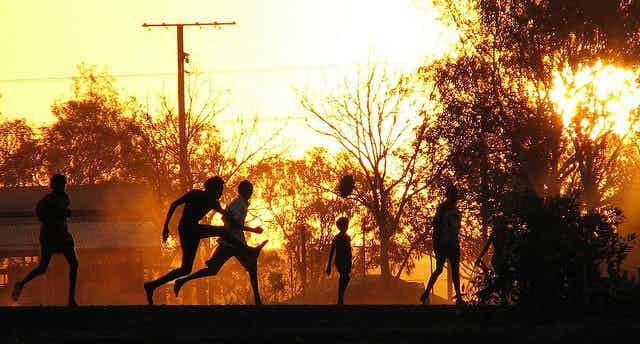We’ve long known that rates of suicide in Indigenous communities are higher than the wider Australian population. But we’re much less clear about why this is the case. Each life lost to suicide reminds us of the need to better identify the causes and implement effective prevention strategies.
Between 1994 and 2006, the rate of suicide in Indigenous people averaged 25.7 per 100,000 people – about 70% higher than in non-Indigenous Australians. Although rates have been decreasing in recent years, suicide among Indigenous people remains disproportionately high relative to non-Indigenous Australians.
In Indigenous children younger than 15 years, the suicide rate was more than seven times higher than their non-Indigenous peers. And in the 15-to-24 age group, Indigenous youth had a 3.6 times higher suicide rate than non-Indigenous youth.
Collecting reliable data is difficult, which means there is no accurate baseline information about Indigenous deaths by suicide. The identification of suicide risk factors and causal pathways has often been based more on anecdotal reports than hard evidence.
And we don’t know whether existing suicide prevention programs are effective because of a lack of rigorous and objective evaluations.
So, why are rates of suicide so high in Indigenous communities?
Based on information contained in the Queensland Suicide Register (QSR), we are able to say that many risk factors for suicide are the same for both Indigenous and non-Indigenous populations.
We know, for instance, that factors such as substance abuse and unemployment elevate the risk of suicide for Indigenous and non-Indigenous people. It’s also widely acknowledged that those risk factors are more prevalent in the Indigenous population than the non-Indigenous population. There is no question that better efforts are needed to address avoidable risk factors for suicide, such as alcohol and drug abuse.
However, there are many other risk factors for suicide that are less well recognised, such as bereavement and relationship conflict. These life events appear to feature more commonly in Indigenous suicides than non-Indigenous suicides, perhaps because of cultural influences.
Looking at Indigenous suicide cases in the QSR, for example, 11.1% of Indigenous people who died by suicide had recently lost a significant person in their lives, compared with 8% of non-Indigenous cases. Relationship conflict prior to death, too, was a significantly more common occurrence among Indigenous (17.4%) than non-Indigenous suicides (9.4%).
Even though we are able to identify higher rates of suicide among our Indigenous population, and have some knowledge about risk factors, the disparities go far beyond different levels of exposure to a comparable set of risk factors. Here, numbers can tell only part of the story – the rest is qualitative.
As a social issue, suicide is entwined with tangible and intangible influences of gender, ethnicity, connectedness, and mental and physical well-being. Above and beyond this already complex network of influences, Indigenous suicide is linked with difficult questions of colonisation, dispossession, racism and social marginalisation.
As some have put it, Aboriginal suicide is different. And they’re right. Many of the issues faced in Indigenous communities, which elevate the risk of suicide, have their roots deep in inter-generational suffering. Great cultural sensitivity should be applied when designing effective suicide-prevention strategies to tackle social issues of such importance and magnitude.
But there are also unique aspects of Indigenous society and culture that offer hope for the future in reducing the burden of suicide mortality. Indigenous society promotes social cohesion, extended familial ties and spontaneous support, which can all lower the risk of suicide. After all, suicide was almost unknown in traditional Aboriginal society.
By re-integrating group identity, feelings of empowerment, repossession and community pride into the lives of Indigenous people, these protective characteristics can be given the chance to re-emerge and flourish.
This process may take several decades – a time largely dictated by political choices and directions, and sociocultural adaptations – but it is not beyond our reach. Indigenous suicide can be reduced.
If you or someone you know needs help contact Lifeline’s 24-hour helpline on 13 11 14, SANE Australia on 1800 18 7263 or the Beyondblue Info Line 1300 22 4636.

